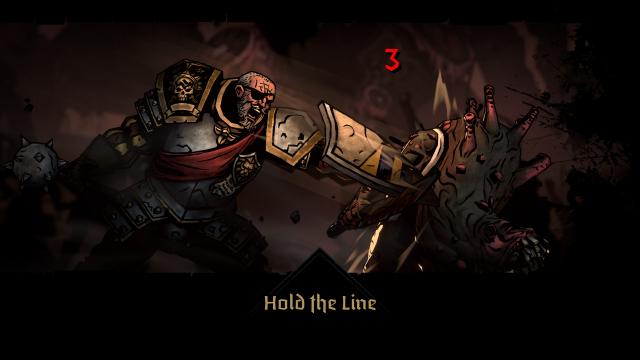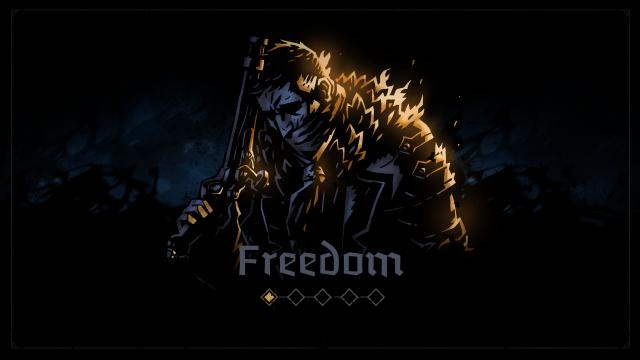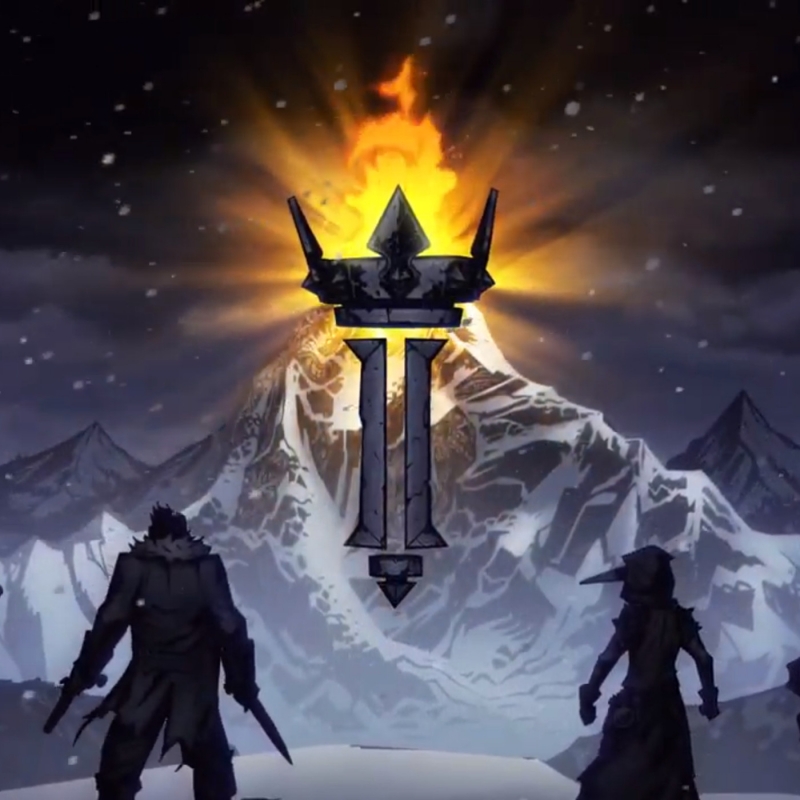
Darkest Dungeon II (PC) - Review
by Paul Broussard , posted on 11 June 2023 / 2,640 Views2015’s Darkest Dungeon was one of the most unique titles of the previous decade, combining turn-based strategy gameplay with dungeon crawling, character building, and RPG mechanics. While that may not sound especially creative, what set Darkest Dungeon apart was the heavy emphasis on permanence and forcing the player to “roll with the punches.” The title screen featured a warning basically telling the player that bad luck would often hit them hard, and that it was their responsibility to make the best of a bad situation. Very little in the gaming world is more crushing than watching a character you’ve sunk days into developing and upgrading die off in an unfortunate series of enemy crits, or a cascade of party members scaring themselves into cardiac arrest. While I can’t say that I loved every second of it (perhaps much in the same way one doesn’t love having their meticulously crafted sand castle repeatedly kicked down by a bully), it did at least stand out as a highly original and interesting spin on dungeon crawling RPGs.
Darkest Dungeon II, conversely, feels like a response to some of those frustrations, with design choices that ultimately diminish the potential negative effects of RNG and make the repercussions of defeat far less devastating. This removes most of the unique soul of the original title, resulting in a game that winds up caught between worlds.

Darkest Dungeon II stumbles right out of the gate with its presentation, especially when compared to its predecessor. The narrative setup of the original was perhaps one of its stronger points. While the lore wasn't particularly complex, the way it set itself up as a mystery to be slowly peeled back rewarded exploration and encouraged players to stick through some of the more... aggravating parts of the game. Conversely, Darkest Dungeon II’s lore is much more convoluted but winds up largely being a confusing mess. There are times when it appears to be a prequel to the original, other times when it seems to be an entirely original world, and still others when it seems like it’s going for the “it was all a dream” angle.
That issue with the presentation extends to the explanation of the game’s mechanics as well. Darkest Dungeon II is probably one of the best examples in a while of why it’s important for developers to stagger the introduction of new mechanics; there’s simply no way new players are going to comprehend (let alone remember) upwards of 30 multi-paragraph tutorial messages within the first 10 minutes. The original title featured a similar number of mechanics but did a much better job of introducing them piece by piece, whereas Darkest Dungeon II just vomits out new gameplay elements in succession. And I probably got off relatively easy having played the original; I can’t imagine what someone who's completely new to the series and has to learn every single mechanic from scratch would feel like.

Quibbles about narrative and tutorials aside, once you get into the core gameplay loop of Darkest Dungeon II it quickly becomes apparent that this is an entirely different type of experience. If you come into the game expecting it to play like the original Darkest Dungeon (as one might reasonably do, considering it's named “Darkest Dungeon II”), then you'll probably leave disappointed. While the turn-based combat and skill leveling elements remain intact from the original, this entry tosses aside the dungeon crawling and town building elements in favor of emulating a roguelike. Instead of spelunking in some procedurally generated ruins, individual runs now consist of your heroes saddling up in a carriage and driving down a series of roads, with occasional forks to choose between. You can never retread a path, however; moving forward is your only option, so the decision on where to go can be fairly weighty, with hazards, battles, friendly NPCs, and more on the road.
Having said that, the actual act of driving the carriage is pretty superficial, with player control limited to moving left and right to collect various bits of gold left on the roadside. Skillful driving can’t result in things like avoiding traps or discovering meaningful artifacts, whereas careful exploration could in the original. For as much publicity as the carriage got in terms of being a major gameplay innovation, it feels like it could have been replaced with a point and click system without losing anything of value. That might even have improved the experience as well, because after about 30 or so hours of watching the same carriage trudging slowly down increasingly lengthy roads, I was getting pretty tired of it and just wished there was a way to skip to the next event.

Once you depart from the initial starting point in your carriage, your next objective is to navigate through the hostile area and reach an inn, fighting enemies and dealing with other obstacles along the way. Make it to an inn and your heroes can recover their health and stress before moving onto the next area; this, in turn, has its own enemies to fight and inn to reach. Areas get progressively tougher and longer until you reach the chapter's boss. There are five of these in total, and the game will absolutely make you work for each one.
So far, this might not seem too dissimilar to the original Darkest Dungeon, but the catch is that almost every RPG element - from leveling your character, to leveling up their moves, and even their relationships with their companions - is self-contained in that one run. If you die or you retreat then almost everything resets, which means that you have to make it through every area in a single run to face the boss. This also means that permadeath is entirely gone as well; while your characters can die during a run, they respawn at the beginning of a new run. The consequences for mistakes (and/or bad luck) are simultaneously harsher and more lenient than before: harsher because retreating means losing a sizable amount of travel progress, all of your character upgrades, and potentially a ton of time, but more lenient as dying no longer means losing someone that you may have sunk a significant chunk of resource investment into.

I suspect that opinion on these changes will vary significantly, but I’d argue that both are ultimately detrimental to the game because they undermine much of the strategy that was previously baked into every moment of the original Darkest Dungeon. To take one example, having an injured party close to the end of a dungeon presented a weighty decision in the original title. Retreating meant losing a lot of progress that would have to be redone later, but also guaranteed survival, while trying to stick it out could mean better rewards and, more importantly, story progress, but could also result in a serious handicap if a high investment character died. This led to consistent tense decision-making with a lot on the line. In Darkest Dungeon II, conversely, there is never any benefit to retreating between inns; you lose exactly as much as you would with a party wipe.
Frankly, that all makes the bad strings of RNG that can kill your run go from tolerable to grating. At least in the original game there was a sense of satisfaction that could come with retreating from a string of bad luck, in knowing that you recognized when things were getting out of hand and had managed to cut your losses and live to fight another day. As the title card suggests, you made the best of a bad situation. In Darkest Dungeon II, there is no making the best of a bad situation. If you do get a string of bad luck, then 3-4 hours of progress can easily just vanish without any satisfaction of knowing a smart decision kept things from being even worse.

There are, of course, ways to control for much of the bad RNG, and as you unlock permanent upgrades with the game’s meta-currency, you’ll find yourself anticipating and adapting to it. But this brings me to another issue, which is that Darkest Dungeon II makes it effectively necessary to fail in order to succeed. The various unlockables via the meta-currency are largely essential to arriving at the bosses in good enough shape to win. You earn more meta-currency by more failed runs, which means there’s already a level of failure required to win, but the initial meta-currency reward rate is pretty paltry. Instead, the game gives you the option to invoke penalties on yourself to increase meta-currency gain, effectively encouraging you to set out on doomed runs in order to unlock enough stuff to make a pass at a run later on.
I find this all just incredibly disincentivizing to play. There are plenty of tough video games (the original Darkest Dungeon included), where your odds at beating a boss on your first attempt are not good. But it almost always is at least possible, and that’s what keeps those failed attempts interesting. If the original Darkest Dungeon had stuck a sign up basically saying that I wasn’t allowed to progress to the final boss of the Weald until I had spent five or so hours dying repeatedly first, I probably would have lost a lot of my incentive to even try. It’s like the developers set out to recreate the experience of the Biblical story of Moses being cursed to wander in the desert for 40 years before being allowed into the promised land.

This is the crux of Darkest Dungeon II, and what I suspect is the breaking point that will split player opinion. If you're willing to wander in that proverbial desert (albeit for 10-15 hours rather than 40 years) in order to gain the necessary upgrades, skills, and team composition, you'll find a rewarding and challenging combat system that's simultaneously brutally challenging and very addicting. Designing a team that takes full advantage of those hard-earned skills and finally sets you up to start bulldozing the swarms of random encounters that demolished you earlier on is, no doubt, an incredibly satisfying experience. But that is one hell of an ask for a game to make of its players, and I can’t blame anyone who isn’t willing to drop $30 (or $40 on Steam) for “you can start having fun with the game after 10 hours.”
That said, even when you do really start engaging with it and the combat starts getting fun, Darkest Dungeon II runs at an absolute snail’s pace. One of the cardinal rules of roguelikes, or any title where death is a constant, is that the game should make it as quick and easy as possible to get right back into the action. Not Darkest Dungeon II, however; it has about as little respect for the players’ time as any game I’ve come across.
Individual runs can be quite long: going from the starting point to killing a chapter boss for the first time will probably be three or so hours on the shorter end of the scale. While some of that is because there’s a good amount of stuff you need to do before confronting the boss, a lot of it is just plain wasted time. Every time you start a new run, the game makes you sit through what might as well be a cut scene where you travel between three different points to spend your meta-currency, unlock skills for your heroes, and then actually equip those skills and choose your heroes for the party. This could have all been combined into a single menu and taken a fifth of the time it does, and the game even then has the nerve to force you into a meaningless tutorial fight that takes up another minute or so before actually letting you pick a region and proceed from there. This might not sound like a lot on paper, but trust me, after your 50th or so failed run, it becomes an experience on par with rubbing your face against a cheese grater.

There’s also a good bit of general quality-of-life stuff that I think could have been addressed to smooth out the experience. The RNG for map design doesn’t appear to have any limitations on how frequently the same random event can occur, which can result in some areas becoming very repetitive. In one area, I had the same random encounter with enemies occur four times. There are also a few glitches that, I’ll admit, brought me very close to the brink of just swallowing my cherished journalistic pride and publishing a review for a title that I hadn’t quite beaten. One such glitch entailed an enemy healing its allies in an infinite loop, never letting it become my turn and effectively soft locking me, rendering an hour and a half of progress dead on the spot. And if you think losing a ton of investment because of your own mistake hurts, just wait until you lose it due to no fault of your own.
In a way, Darkest Dungeon II reminds me of Salt and Sacrifice; both sequels to cult classic titles that tried to innovate by mashing up with entirely different genres, both significantly worse off as a result. If you're looking for a roguelike and don’t mind one of the highest barriers to entry that I’ve seen in any single player game, then you may find quite a bit of enjoyment out of Darkest Dungeon II. For anyone else, this is a tough sell.
You will probably like Darkest Dungeon II if: You really enjoy roguelikes and don't mind having to put a lot of investment into a game before you start to see returns.
You might like Darkest Dungeon II if: You enjoyed the combat and party compositions elements the most from the first game, and you temper your expectations on it being like the original title.
You will probably not like Darkest Dungeon II if: You're looking for a game that plays like the original, or are looking for one that doesn't take too much time to get invested into.
VGChartz Verdict
4
Poor
This review is based on a digital copy of Darkest Dungeon II for the PC


























